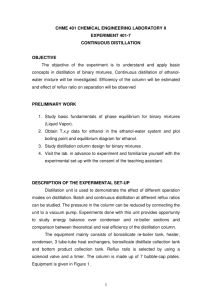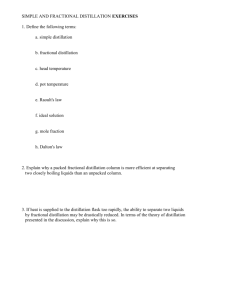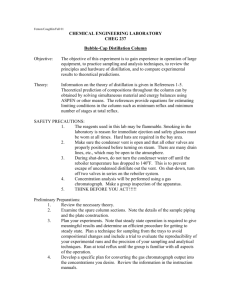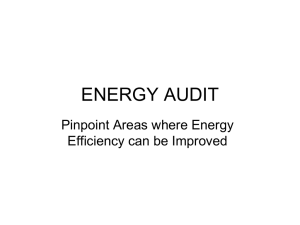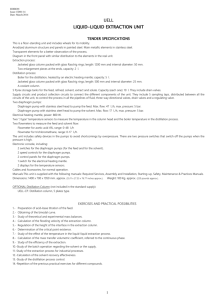Multistage Distillation
advertisement
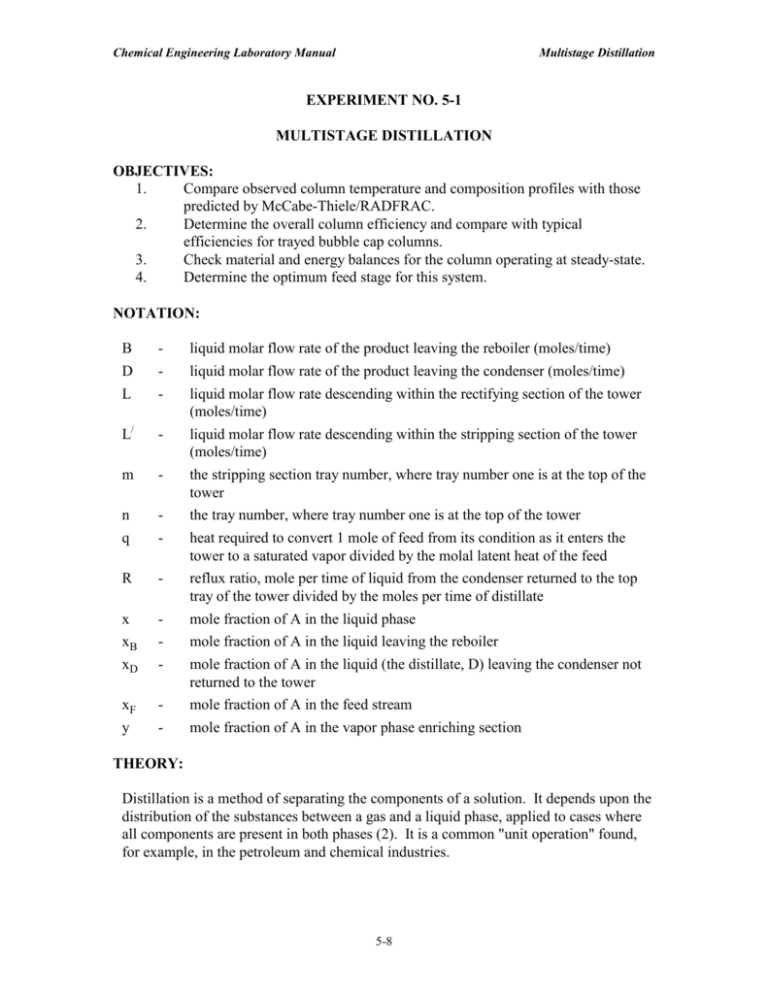
Chemical Engineering Laboratory Manual Multistage Distillation EXPERIMENT NO. 5-1 MULTISTAGE DISTILLATION OBJECTIVES: 1. Compare observed column temperature and composition profiles with those predicted by McCabe-Thiele/RADFRAC. 2. Determine the overall column efficiency and compare with typical efficiencies for trayed bubble cap columns. 3. Check material and energy balances for the column operating at steady-state. 4. Determine the optimum feed stage for this system. NOTATION: B - liquid molar flow rate of the product leaving the reboiler (moles/time) D - liquid molar flow rate of the product leaving the condenser (moles/time) L - liquid molar flow rate descending within the rectifying section of the tower (moles/time) L/ - liquid molar flow rate descending within the stripping section of the tower (moles/time) m - the stripping section tray number, where tray number one is at the top of the tower n - the tray number, where tray number one is at the top of the tower q - heat required to convert 1 mole of feed from its condition as it enters the tower to a saturated vapor divided by the molal latent heat of the feed R - reflux ratio, mole per time of liquid from the condenser returned to the top tray of the tower divided by the moles per time of distillate x - mole fraction of A in the liquid phase xB - mole fraction of A in the liquid leaving the reboiler xD - mole fraction of A in the liquid (the distillate, D) leaving the condenser not returned to the tower xF - mole fraction of A in the feed stream y - mole fraction of A in the vapor phase enriching section THEORY: Distillation is a method of separating the components of a solution. It depends upon the distribution of the substances between a gas and a liquid phase, applied to cases where all components are present in both phases (2). It is a common "unit operation" found, for example, in the petroleum and chemical industries. 5-8 Chemical Engineering Laboratory Manual Multistage Distillation Distillation is based on the principle that when sufficient energy is transmitted to a mixture containing components of differing volatilities; the more volatile components (i.e. having a higher vapor pressure) will vaporize preferentially with respect to the less volatile components. In distillation only a fraction of the liquid is vaporized; with respect to the original liquid the vapor is richer in the more volatile components and the residual liquid is richer in the less volatile components. The vapor is condensed and then partially vaporized, this process is repeated until the vapor has the desired composition. The remaining liquid from each partial vaporization is countercurrently and intimately contacted with the vapor, which is leaner in the more volatile component from the preceding partial vaporization stage. The point in a distillation tower where the liquid and vapor contact is called a stage. The contacting is done typically by intimate mixing on sieve trays, in packed sections, or by bubble caps, as in this experiment. When the stages are arranged in a vertical fashion so that the vapors evolving from one stage contact the descending liquid from the stage above, we have a distillation "column" or "tower", see Figure 18-8 (1), or Figure 11.4-1 (6). The section above the point where the feed enters the tower is referred to as the enriching or rectifying section. In the enriching section the falling liquid "washes" the less volatile components from the rising vapor. The section below the feed is referred to as the stripping section. In the stripping section the liquid in the bottom of the tower is partially vaporized, the vapor then rises stripping the descending liquid of the more volatile components. For liquid to be provided to the top stage, some of the condensed vapors from this stage are returned as reflux. For vapors to be supplied to the lowest stage, some liquid from the lowest stage is vaporized in the "reboiler". Two common methods used to calculate the relationship between the number of trays, liquid/vapor ratios, and product composition for a binary mixture (A and B) are the Ponchon and Savarit method and the McCabe and Thiele method. The former requires detailed enthalpy data while the latter does not and is therefore also less accurate. Often the McCabe-Thiele method is adequate because the enthalpy effects are not large. McCabe-Thiele Method The primary assumption is that the operating lines in a x-y coordinate system plot are straight for each tower section. This will be true if enthalpy effects are negligible. The operating line for the enriching section can be obtained from a material balance around the enriching section including the condenser, see Figure 18-8 (1). If the condenser is a total condenser then the operating line equation is 5-7 Chemical Engineering Laboratory Manual y n 1 Multistage Distillation L D xn xD LD LD 1 A material balance around the stripping section including the reboiler yields the operating line for the stripping section y m 1 L/ B x xB m L/ B L/ B 2 The operating line for the feed, the q-line, is established from a material and an enthalpy (energy) balance around the feed stage, yielding y q x x F q 1 q 1 3 If the feed composition and thermodynamic state, xD, xB, and the reflux ratio are specified, the operating lines can be drawn on a x-y coordinate system plot. From the graph the number of theoretical stages for the desired separation can be determined. Note that five of the above mentioned variables need to be known to determine the sixth, graphically. EQUIPMENT: A simple schematic arrangement of a distillation column with accessories is shown in Figure 18-8 (1). The distillation equipment in the laboratory is more elaborate. It was made by the Brighton Corporation of Cincinnati, Ohio. There is a set of drawings provided to aid in understanding its construction and arrangement. The piping diagrams are drawings BD-20194EL, BC-80841-EL and BC-80842-EL(6). The distillation column itself contains 20 bubble-cap plates. Each plate has 3 bubble-caps. The column is made up of 18 copper sections, each 6 inches high, each flanged at both ends and bolted together with a plate between each pair of adjacent sections. The two top sections, 19 & 20, are of glass, so bubble-cap action may be observed. The downcomers have an inside diameter of about 1 inch (eye-ball estimate). The column sections have a diameter of 8 inches; flange diameter is 11 inches; 9-l/2 inch bolt circle with 12 bolts per circle. The column is uninsulated; therefore, it will not operate adiabatically. A kettle is provided to furnish heated feed. A feed pump is provided. A calandria reboiler is located in the bottom of the column. Three water cooled overhead condensers operate in series for total condensation of the overhead vapors. Piping is such that feed may be introduced to any of the lower 18 plates or to the top of the column. Tanks are provided for overhead and bottom product collection, but these 5-8 Chemical Engineering Laboratory Manual Multistage Distillation streams should be sampled using the line taps. Instrumentation is provided for measuring temperatures and pressures within the system and for measuring flow rates on the various streams. Sampling containers are arranged along the column to obtain liquid samples from alternate plates. PREPARATION: Before coming to the laboratory prepare the following aids: 1. A vapor-liquid equilibrium diagram (Txy and XY diagrams) for the ethanol-water system at 13.25 psia. ASPEN Plus can be used to generate these diagrams using the proper physical property set. You should verify the accuracy of the generated diagrams with literature data; Perry’s 6th edition gives an enthalpy-concentration diagram for the ethanol-water system. 2. You will be feeding a ~0.12 mol fraction ethanol in water stream to a 20 stage distillation column at a flow rate of 0.2 gpm and a temperature of 60 C. Your target product concentration is 0.70 mol fraction ethanol in the distillate and 97% recovery of ethanol in the distillate. Use McCabe-Theile/ASPEN RADFRAC to estimate the reflux ratio required and optimal feed stage for this separation when the Murphree stage efficiency (Emv) is 0.50. Assume that the reboiler does not count as an additional equilibrium stage. Use an overall column material balance to determine the distillate product flow rate in gallons per minute. From ASPEN using NRTL, the molar density of 12 mol% ethanol at 60 C is 2.63 lbmol/ft3, and the molar density of 70 mol% ethanol at the bubble point is 1.26 lbmol/ft3. PROCEDURE: 1. Safety: Hard hat and safety glasses required. The steam lines, feed kettle, reboiler, and column all operate at elevated temperatures. 2. Familiarize yourself with the distillation column system. Know the Feed system, Reboiler Condensate (Bottoms) system, Reflux system, Utilities Pump system, and Steam system. 3. Ensure that feed composition in kettle is at least 0.12 mol fraction of ethanol. 4. Turn on cooling water supply to the kettle condenser and the top product condensers. Confirm that condenser vent line to atmosphere is open; this allows non-condensable gas to exit the column during startup. 5. Open feed valve on desired feed tray, and verify that all other tray valves are closed. 6. Open gate valve for steam coming from header (located on east wall). Make sure ball valve for the steam condensate is open (going towards the absorber). 7. Verify level in feed kettle and reboiler. Collect a feed sample for GC analysis. 8. Turn on the power supply to the control panel. 9. Startup the computer. On the Desktop, open Distillation Control Strategy. Click Debug, and then Start Strategy. 5-7 Chemical Engineering Laboratory Manual Multistage Distillation 10. Put feed kettle temperature control loop in AUTO in PAC Display Runtime Basic (setpoint at 140 F). 11. With valves open from kettle to pump and then to column, start the feed pump. Adjust the feed flow rate with the rotameter to achieve 0.1 gpm. 12. Set reboiler temperature in AUTO at 215 F in PAC Display Runtime Basic. 13. Set the Bottoms level to be 80% in PAC Display Runtime Basic. 14. Temperatures for each stage of the column can be viewed in PAC Display Runtime Basic by opening the Unit Display. 15. Once the overhead temperature reaches 70 C, increase the feed flow rate to 0.2 gpm. 16. Monitor reflux flow rate on display panel. Once the reflux flow rate exceeds 0.1 gpm, start the product flow rate at a value corresponding to your desired reflux ratio. 17. Visually observe the top two stages through the glass wall. Look for flow patterns that could lower tray efficiency, such as weeping, entrainment, and liquid splashing down the downcomer. 18. Carefully touch the atmospheric vent line to see if it is hot. If it is hot, increase the condenser cooling water flow rate and notify the instructor. 19. If level gets too high in Bottoms, Reflux, or Distillate tanks, open valves to drain tanks and start the Utility Pump to drain tanks into the Kettle. 20. Monitor column temperatures and flow rates (including reflux rotameter) to verify steady state operation. Verify that all sample jars are empty. 21. Write down all temperatures and flow rates. 22. Sample the overheads distillate and the bottoms product using the needle sample valves. Open the bottoms sample valve slowly and carefully – this sample will be hot. The person collecting samples should wear rubber gloves. 23. Manually actuate the sample valves with instrument air. Once all the sample jars are at least half filled, bleed instrument air pressure to close the sample valves. 24. Transfer samples to sample bottles and allow cooling to room temperature. 25. Measure reboiler condensate flow on the display panel labeled Bottoms flow rate. When you have completed the distillation run, observe the following procedures in shutting down. 1. Turn off steam supply manual valves at the column and at the main supply header. 2. Turn off the feed pump. 3. Close out of PAC Display Runtime Basic. In PAC Control Basic, click Stop Strategy and close out. 4. Turn off power supply to display. 5. Turn off the cooling water after the temperature at the top of the column has dropped to 40 C. 6. Analyze samples for mole fraction ethanol using GC or refractive index. REPORTING: 5-8 Chemical Engineering Laboratory Manual Multistage Distillation In reporting this experiment you should: 1. Plot temperature versus stage number. Compare your measured temperatures with those predicted from your measured compositions via your Txy diagram. Also compare your measured temperature profile with your RADFRAC generated profile. 2. Plot liquid ethanol mole fraction versus stage number. Compare your measured composition profile with profiles generated by McCabe-Thiele/RADFRAC. 3. Calculate the molal flow rates of vapor and liquid at the top. Check your overall column material balance. 4. Determine your experimental reboiler and condenser duties in Btu/hr. Check your overall column energy balance. 5. Show the determination of theoretical stages (plates) needed to achieve the observed separation by McCabe-Thiele and RADFRAC. 6. Compute the overall column efficiency from your data. Compare this with typical efficiencies reported in the literature for trayed bubble cap columns. 7. Estimate the change in molal vapor flow from top to bottom due to column heat losses. How would this affect your calculated column efficiency? REFERENCES: 1. McCabe, Smith and Harriott, Unit Operations of Chemical Engineering, Fifth Edition, McGraw-Hill Book Co. (1993). 2. Treybal, Mass Transfer Operations, Third Edition, pp. 185, 342-357, 371-419, McGraw-Hill Book Co. (1968). 3. Perry, Green and Maloney, Chemical Engineers' Handbook, Sixth Edition, pp. 1837 to 18-19, McGraw-Hill Book Co. (1984). 4. Perry, Ibid, Fourth Edition, pp. 13-2 to 13-10, 18-17, McGraw-Hill Book Co. (1963). 5. Perry, Ibid, Third Edition, p. 575 (1950). 6. C.J. Geankoplis, Transport Processes and Unit Operations, Third Edition, Prentice Hall PTR (1993). 7. Operating Instructions for Complete Model "A", Laboratory Distillation Unit, SDSM&T, Serial No. 4269, Brighton Corporation (1961). 8. International Critical Tables, Vol. 3, p. 310. FOR ADDITIONAL INFORMATION: 5-7 Chemical Engineering Laboratory Manual 9. 10. Multistage Distillation Chu, Ju-Chin, et al., Distillation Equilibrium Data, Reinhold Publishing Corp. (1950). Chu, Ju-Chin, et al., Vapor-Liquid Equilibrium Data, J. W. Edwards, Publisher (1956). 5-8
